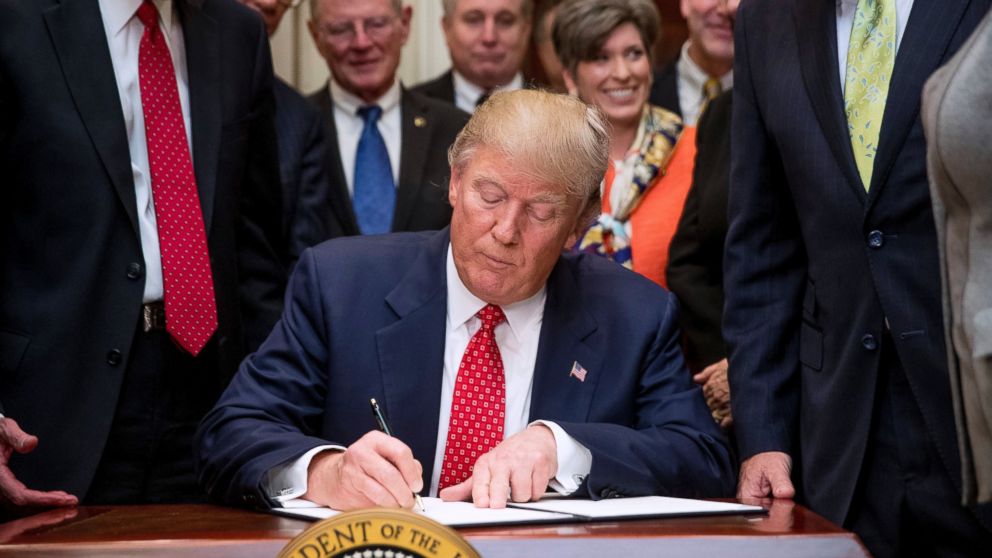How Trump's new travel ban executive order compares with its predecessor
— -- President Donald Trump signed a new executive order Monday limiting immigration to the United States, revoking and replacing a similar order issued in late January.
The original order, which the White House said was issued to protect the homeland from terrorism, caused confusion for many travelers and visa holders, sparked protests across the U.S. and led to a slew of lawsuits.
That order has been held up in the courts since the 9th Circuit Court of Appeals blocked its continued implementation last month. The Trump administration has said that the new order was written in coordination with the Departments of State, Homeland Security and Justice, which will be responsible for enforcing the order, as well as designed to withstand any possible legal challenges.
The White House worked closely with those departments "to create an order that addresses previous concerns and protects the homeland and every one of our citizens," said DHS Sec. John Kelly during on-camera remarks Monday.
However, critics said the new order is just another "Muslim ban."
"The Trump administration has conceded that its original Muslim ban was indefensible. Unfortunately, it has replaced it with a scaled-back version that shares the same fatal flaws," said Omar Jadwat, director of the ACLU’s Immigrants’ Rights Project, in a statement.
The president signed the order off camera and did not participate in the public remarks with his Cabinet secretaries regarding the implementation of the new order.
Here are the key similarities and differences between the Jan. 27 executive order and the new order signed Monday:
What's new
The old order is officially revoked as of the effective date of this new order, which is March 16 at 12:01 a.m. The administration set the effective date for next week so that the roll out would be an orderly process, according to officials.
Iraq is removed from the list of seven countries from which regular immigration is temporarily banned. For the next 90 days, immigration is suspended from Sudan, Syria, Iran, Libya, Somalia and Yemen. The administration explained that in negotiations between the State Department and the government of Iraq, the U.S. got the assurances it needs that “Iraq will increase cooperation with the U.S. government on the vetting of its citizens applying for a visa to travel to the United States. As a result of the increased information sharing, Iraqi citizens are not affected by the Executive Order.”
"[I]ntense review over the past month identified multiple security measures that the State Department and the government of Iraq will be implementing to achieve our shared objective of preventing those with criminal or terroristic intent from reaching the United States," said Secretary of State Rex Tillerson Monday.
The 10-day implementation delay, rather than making the order effective immediately, is also new.
Kelly said he spent much of the day today and last week briefing members of Congress on the "ins of the outs of this executive order."
"There should be no surprises, whether it's in the media or on Capitol Hill," he said.
This new order no longer puts a blanket, indefinite ban on Syrian refugees.
It no longer bans refugees who "have been formally scheduled for transit by the State Department."
And, unlike the previous order, it allows those already in possession of a valid visa to enter the country, no matter their origin. There is also clear language that dual U.S. nationals are not banned.
The new order no longer makes exceptions for religious minorities, which was a huge point in the various legal challenges faced by the original order. Instead, it offers new language that defends the intent of that language in the old order, which it revokes.
It makes new claims to defend the refugee suspension and review, saying that the attorney general has reported that "more than 300 persons who entered the United States as refugees are currently the subjects of counterterrorism investigations by the Federal Bureau of Investigation.” When asked earlier today by reporters on a conference call, the Justice Department would not say how many of those people are from the six countries listed in the immigration ban nor would it provide any further details about the how the number was derived.
What remains
The order again suspends the entire refugee program for 120 days.
"The State Department will implement the provisions in this order that allow for the admissions of refugees when it is determined they do not pose a risk to the security or welfare of the United States," said Tillerson.
Again it limits the total number of refugees to be admitted in 2017 to 50,000.
The six Muslim-majority countries included in the new order are still banned from entering the United States for 90 days.
"Three of these nations are state sponsors of terrorism. The other three have served as safe havens for terrorist countries, countries where governments have lost control of their territory to terrorist groups like ISIL or al-Qaeda and its affiliates," said Attorney General Jeff Sessions during remarks.
The U.S. government has the right to make case-by-case waivers/exceptions when it’s in the national interest to do so.
As with the previous order, the secretaries of state and homeland security will issue a joint report "on the progress in implementing this order within 30 days of the date of this order, a second report within 60 days of the date of this order, a third report within 90 days of the date of this order, and a fourth report within 120 days of the date of this order."




